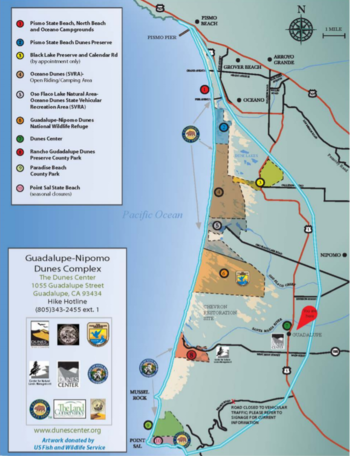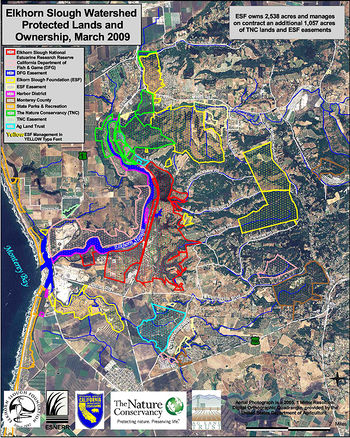The Nature Conservancy (TNC)



Summaries of Environmental Topics on the Central Coast of California created by the ENVS 560/L Watershed Systems class at CSUMB.
Background
The TNC is a non-profit organization founded in 1951 and since then grew more than 1 million members while conserving more than 119 million acres of land, and operating more than 100 marine conservation projects. The agency works in 72 countries around the world.[3] The TNC's mission is to ensure that people can thrive without destroying the resources we depend on.[4] The TNC strives for healthy landscapes to improve livelihoods, create rural jobs, improve food and water security, protect habitats, and reduce the risk of climate change. This is achieved by communicating and partnering with the community, using science to improve mitigation practices, and influencing policy.[5] The TNC protects water by reforestation and improving farming practices[6], and preserves natural habitats to protect the coasts and quantifies the ocean's resources.[7] Strategies are developed to ensure healthier quality of life for people in cities, improved habitat for wildlife, and that people have access to quality green space. [8] To combat the effects of climate change, the TNC is developing practical and cost-effective solutions around the world to help people slow the rate of climate change and deal with its impacts.[9]
Governance
The TNC is organized as a single organization with a volunteer Board of Directors that are responsible for delegating day-to-day operations to the President and Chief Executive Officer who then delegates responsibilities to their executive team.
The Board of Directors established chapters at state and country levels with each run by a director. This director manages TNC's annual budget and plan which then gets reported to the President and the Board of Directors.
The Board of Trustees are also volunteers with diverse strengths that assist and advise TNC chapters on strategic issues and setting goals.[10]
To determine ethics and legalities of the TNC, the Audit Committee assists in oversight and monitoring of TNC’s systems of internal controls and risk mitigation, in ensuring compliance with legal and ethical standards and in selecting and hiring of the internal and independent auditors. Per the bylaws, audits are preformed annual by an independent certified public accountant. The reports can be found here. [11]
Central Coast Projects
Guadalupe–Nipomo Dunes Project
Part of the dunes, previously owned by a oil company with a history of oil development and abandoned oil wells, was transferred to the TNC in 1989. This resulted in limiting land use to recreational activities. The TNC began managing this project in 1999 with a goal to sustain the long-term viability of the Dunes Complex and its appropriate enjoyment by humans.[12] The Guadalupe–Nipomo Dunes is the largest intact coastal dune ecosystem on Earth located between Pismo State Beach to Point Sal in central California. This 18-mile long dune now belongs to the U.S. Fish and Wildlife Service, Santa Barbara County, the Land Conservancy of San Luis Obispo County, a number of private parties, and the California State Department of Parks and Recreation to ensure the dunes are protected from incompatible development or use.[13]
Monterey County Project
TNC combines land protection and community-based conservation as well as a sustained effort to introduce good conservation principles into public policy and land-use planning. TNC's future goals are to purchase and acquire conservation easements on key lands in highly threatened, biologically rich conservation areas. Some examples in Monterey County include:[14]
- A $1 million grant from the TNC to the Monterey Bay Fisheries Trust to restore fishing rights providing local and sustainably managed fishery.[15]
- TNC worked with the Monterey County Water Resources Agency, and other local entities to plan, design and facilitate permitting of management strategies that maximize multiple benefits of flood risk reduction, groundwater recharge, community health and safety, and connectivity of riparian and coastal biodiversity to increase long-term climate resilience along the Salinas river.[16]
- In 1971, the TNC purchased wetlands to protect the Elkhorn Slough Reserve from major development.[17]
- The Andrew Molera State Park was first protected by TNC in 1965 when a Molera family member contacted TNC as a holding agency with the intention to turn the land into a state park.[18]
Mount Hamilton Project
This project started in 1998 when the TNC started acquiring parcels of land and later partnering with other organizations to maintain the integrity of the ecosystem. The 1.5-million-acre conservation project safeguards threatened wildlife habitats while streamside forests, woodlands and grasslands form a critical part of the watershed that guarantees a healthy water supply to the San Francisco Bay Area residents.[19]
San Luis Obispo County Project
With the growing human population, the TNC aims to conserve the increasingly threatened biodiversity of San Luis Obispo County. This project has protected more than 18,000 acres of natural areas, open spaces, and grasslands. In particular, TNC's priorities include conserving Cambria Pines, Irish Hills, the Upper Salinas Oak Woodlands, the Carrizo Plain National Monument, and the Salinas, Estrella, and San Juan Rivers. [20]
Links
- Steelhead Management in the Salinas Watershed
- Wildlife Connectivity in California's Central Coast Region
- More information about TNC California can be found on their website.
References
- ↑ https://www.fws.gov/uploadedFiles/Region_8/NWRS/Zone_1/Hopper_Mountain_Complex/Guadalupe-Nipomo_Dunes/Sections/What_We_Do/Conservation/GNDNWR_FINAL_CCP.pdf
- ↑ http://www.elkhornslough.org/protectedlands/index.htm
- ↑ https://www.nature.org/about-us/index.htm?intc=nature.tnav.about
- ↑ https://www.nature.org/ourinitiatives/index.htm?intc=nature.tnav.ourwork
- ↑ https://www.nature.org/ourinitiatives/urgentissues/land-conservation/howwework/index.htm?intc3=nature.lands.lp.splash1
- ↑ https://www.nature.org/ourinitiatives/urgentissues/water/enough-water-for-all/index.htm?intc3=nature.water.lp.r1c2
- ↑ https://www.nature.org/ourinitiatives/urgentissues/oceans/understanding-ocean-benefits/index.htm?intc3=nature.oceans.lp.r1c3
- ↑ https://www.nature.org/ourinitiatives/urgentissues/nature-in-cities/index.htm
- ↑ https://www.nature.org/ourinitiatives/urgentissues/global-warming-climate-change/innovate-and-share-science/index.htm?intc3=nature.climate.lp.r1c1
- ↑ https://www.nature.org/about-us/governance/index.htm?intc=nature.tnav.about
- ↑ https://www.nature.org/about-us/governance/board-of-directors/bylaws.xml
- ↑ https://www.fws.gov/uploadedFiles/Region_8/NWRS/Zone_1/Hopper_Mountain_Complex/Guadalupe-Nipomo_Dunes/Sections/What_We_Do/Conservation/GNDNWR_FINAL_CCP.pdf
- ↑ https://www.nature.org/ourinitiatives/regions/northamerica/unitedstates/california/placesweprotect/guadalupe-nipomo-dunes.xml
- ↑ https://www.nature.org/ourinitiatives/regions/northamerica/unitedstates/california/placesweprotect/monterey-county.xml
- ↑ https://montereybayfisheriestrust.org/news/2017/2/3/news-release-3
- ↑ http://bondaccountability.resources.ca.gov/Project.aspx?ProjectPK=12819&PropositionPK=4
- ↑ https://www.nature.org/ourinitiatives/regions/northamerica/unitedstates/california/placesweprotect/elkhorn-slough.xml
- ↑ https://www.nature.org/ourinitiatives/regions/northamerica/unitedstates/california/placesweprotect/the-nature-conservancy-in-california-1965-andrew-molera-state-park.xml
- ↑ https://www.nature.org/ourinitiatives/regions/northamerica/unitedstates/california/placesweprotect/mount-hamilton-1.xml
- ↑ https://www.nature.org/ourinitiatives/regions/northamerica/unitedstates/california/placesweprotect/san-louis-obispo-county.xml
Disclaimer
This page may contain student work completed as part of assigned coursework. It may not be accurate. It does not necessary reflect the opinion or policy of CSUMB, its staff, or students.